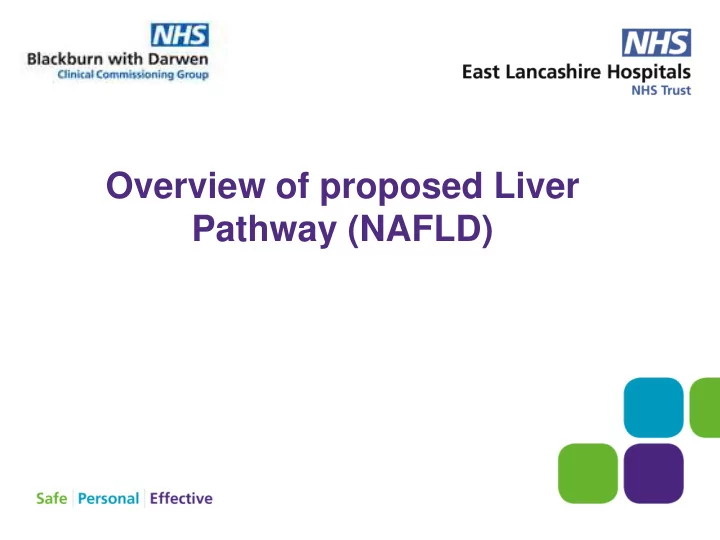

Overview of proposed Liver Pathway (NAFLD)
Stage 1 Stage 1 • All adult patients that have a liver profile requested from the pilot practices will automatically receive an ALT/ALP ratio PowerPoint Template with the other LFT results.
Stage 1 - Results • Liver profile reported on ICE with ALT/ALP ratio
Stage 1 - Results Interpretation Box A: Metabolic Syndrome The International Diabetes Federation (IDF) criteria to diagnose metabolic syndrome: Metabolic syndrome may be diagnosed if the patient has a large waist circumference (≥94 cm in European men or ≥90 cm in South Asian men; ≥ 80 cm in European and South Asian women). Plus any two of the following: HDL-cholesterol <1.0 mmol/L (men), <1.3 mmol/L (women) Triglycerides ≥1.7 mmol/L Blood pressure ≥130/85 mmHg Fasting plasma glucose ≥5.6 mmol/L Issue the patient information leaflet at this stage
Stage 2 - Repeat tests Requesting ‘NAFLD Lifestyle repeat’ on ICE automatically PowerPoint Template orders a liver profile and GGT
Stage 2 - ICE request form PowerPoint Template
Stage 2 - Results Interpretation
Stage 3 - Request liver ultrasound and specialist biochemistry • Request liver ultrasound on ICE • Request ‘NAFLD - FIB4 and specialist liver screen’ on ICE • This automatically requests LFT, AST, FBC, FIB-4, A1AT, ferritin, caeruloplasmin, hepatitis B/C serology, iron/transferrin saturation and autoimmune liver screen • Four request forms printed • A1AT and autoimmune liver screen referred to Immunology at Preston • Caeruloplasmin referred to Manchester Royal Infirmary • All results will be returned via ICE onto EMIS
Stage 3 - Results Interpretation Box B: Quick Reference Guide to interpret specialist liver panel test results Patients stay on the liver pathway if the specialist liver panel test results meet ALL of the following criteria: A1AT ≥1.10 g/L Caeruloplasmin ≥200 mg/L Negative Hepatitis B and C serology Transferrin saturation <50% Negative smooth muscle, mitochondrial (M2/non M2) and LKM antibodies For any other results or for further information on each test, see boxes C-G.
Stage 3 - Results Interpretation Box C: Serum A1AT Alpha-1-antitrypsin deficiency Samples are referred for analysis at the Immunology Laboratory at the Royal Preston Hospital. Avoid sample collection if acute inter-current infection Severe A1AT deficiency (0.6g/L) occurs with incidence 1:2000. Typical presentation includes COPD, emphysema and cirrhosis Reference range (adults): 1.10 – 2.10g/L If the result is within the reference range or higher than the reference range, A1AT deficiency is excluded. If the A1AT is <1.00 g/L, the A1AT phenotyping will be performed. The ‘Z’ allele is most frequently associated with liver disease. - - PI*ZZ homozygotes occur in approximately 1 in 2,000-5,000 births in European populations. Patients with PI*ZZ should be referred to Hepatology. - Box D: Serum Caeruloplasmin Wilson’s disease Samples are referred for analysis at the Biochemistry Laboratory at Manchester Royal Infirmary. Avoid sample collection if acute inter-current infection Presentation of Wilson’s Disease may be hepatic or neurological (clumsiness/ataxia). Reference range (adults): 200-600 mg/L Further investigation is required if the serum caeruloplasmin <200 mg/L - Collect a 24 hour urine sample for copper analysis (please contact Clinical Biochemists if further information is required on 01254 734153/735927) - If 24 hr urine copper is increased, patients should be referred to Hepatology.
Stage 3 - Results Interpretation Box E: Hepatitis B/C Serology Samples are analysed at the Royal Blackburn Hospital. Any positive results are referred for confirmation. Patients with positive serology results should be referred to Hepatology. Box F: Ferritin, Iron and Transferrin Saturation Hereditary Haemochromatosis Samples are analysed at the Royal Blackburn Hospital. Presentation of hereditary haemochromatosis includes abnormal LFT results (ALT), arthralgia/arthritis, late onset diabetes and bronze pigmentation. Causes of increased ferritin include chronic infection/inflammation, malignancy and haematological conditions If the transferrin saturation >50% and ferritin >500ug/L in males/ >350ug/L in females suggest repeat fasting sample for iron and TIBC (exclude alcohol excess) If the above results are repeated on a fasting sample, send a sample for haemochromatosis (HFE) genotyping. Patients that are homozygous for the C282Y variant should be referred to Hepatology.
Stage 3 - Results Interpretation Test Positive result Reticulin (R1) antibodies A positive result is not associated with liver disease. Gastric parietal cell A positive result is not associated with liver disease. antibody Smooth muscle The result is reported as either tubular (associated with type 1 antibodies autoimmune hepatitis) or vascular (commonly seen post viral infections). Mitochondrial (M2) Positive results are associated with primary biliary cirrhosis (or less antibodies commonly autoimmune hepatitis) Mitochondrial (non M2 All patients with positive mitochondrial (non M2) antibodies should antibodies) be referred to Hepatology. LKM (Liver Kidney Mainly present in type 2 autoimmune hepatitis (80% prevalence) Microsome) Antibody Ribosomal antibody A positive result is not associated with liver disease
Stage 3 - FIB-4 FIB-4= age (years) x AST (U/L) Platelet count (10 9 /L) x √ALT (U/L) FIB-4 auto-comments added by the laboratory: <1.30: Review patient and repeat LFTs in 1 year 1.30-3.25: Please request the Enhanced Liver Fibrosis (ELF) test >3.25: Refer to Hepatology for further assessment
Stage 3 - FIB-4 Example
Stage 4 - Enhanced Liver Fibrosis (ELF) Test • The ELF test is a biochemical measurement of the presence and extent of liver fibrosis • Three biochemical markers measured and used to PowerPoint Template calculate an ELF score • PIIINP (amino terminal pro-peptide of type III collagen) • TIMP-1 (tissue inhibitor of matrix metalloproteinase 1) • Hyaluronic acid
Stage 4 - ELF test • Request ‘NAFLD - ELF’ on ICE • Samples will be referred to Biochemistry Laboratory at Leeds for analysis • Samples will only be referred to Leeds for the ELF test if the FIB-4 is 1.30-3.25 and all other liver screen blood tests show no abnormalities that require Hepatology Referral
Liver Pathway Stage 1 LFT Stage 2 LFT/GGT Stage 3 U/S and specialist liver tests Stage 4 ELF test
Recommend
More recommend